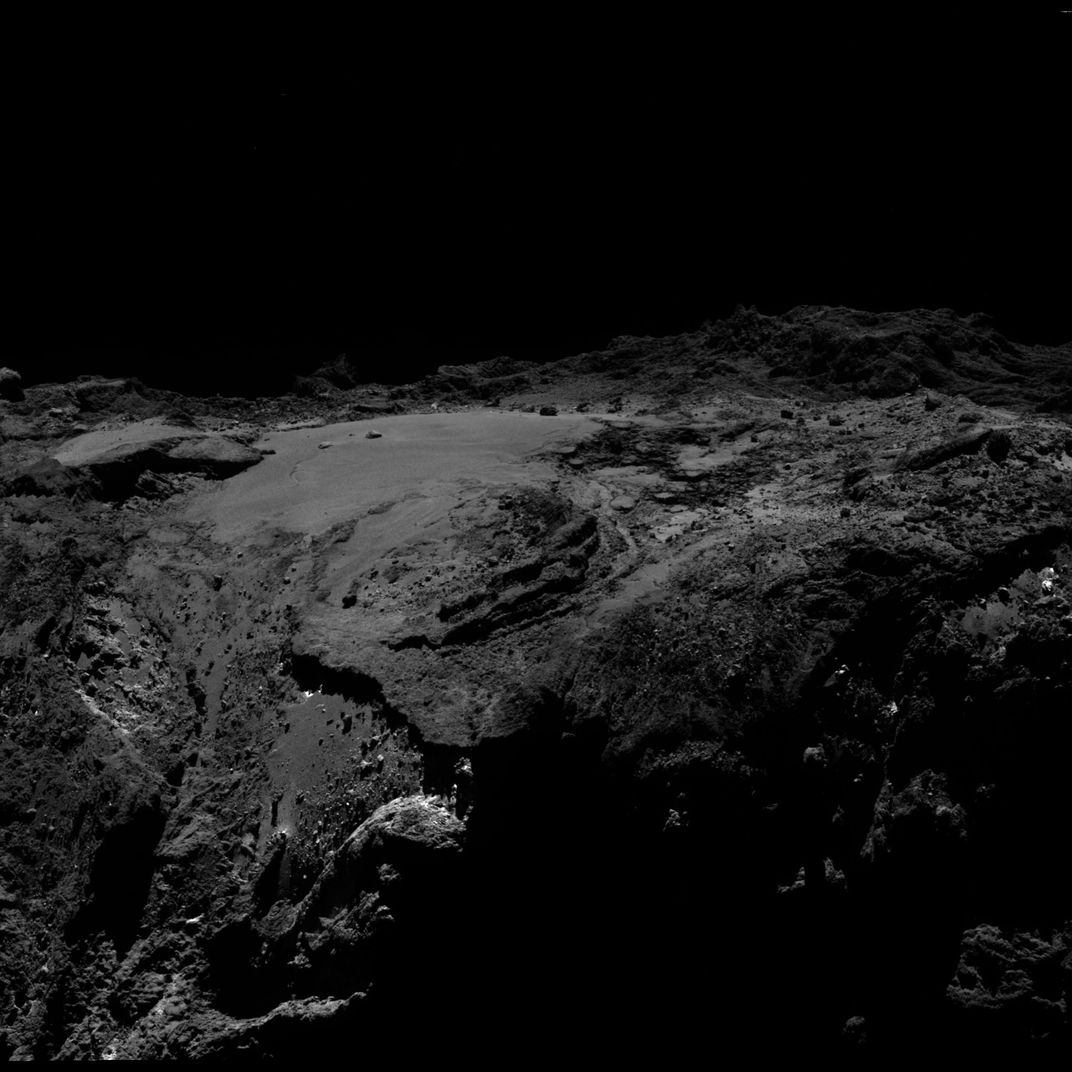Avalanches on Comets May Help Make the Icy Bodies Visible
Tumbling rocks may have lit up Comet Hartley 2, allowing its discovery in 1986
/https://tf-cmsv2-smithsonianmag-media.s3.amazonaws.com/filer/4c/2d/4c2d5dc1-c11c-4bd3-83cd-f53473892677/495296main_epoxi-1-full_full.jpg)
Lifeless, icy comets may circle the solar system in darkness until avalanches awaken them, scraping their surface to reveal icy jets that light them up for people on Earth to see. Falling rocks may have even led to the discovery of Comet Hartley 2, which passed around the sun many times before being spotted in 1986, a new study contends.
"The avalanche process removes overlying material and excavates down to the ices, allowing the comet to be activated," says Jordan Steckloff, a researcher at Purdue University in Indiana. Jets of gas from beneath the newly-scraped ground would turn the comet from a dark ball of ice and rock to an active object with the familiar bright flowing tail.
Comets rotate and tumble as they travel from the outer reaches of the solar system, toward the sun and back again. A faster spin could make a comet’s surface more unstable, allowing rocky debris to slide across its outer layer in an avalanche. These avalanches may scrape away the skin that protects frozen material beneath. When revealed, the ices jump from solid to gas, creating jets of ice and dust that light up the comet.
When NASA's EPOXI mission visited Hartley 2 in 2010, it spotted material jetting from the surface. The jets cause the comet to rotate, sometimes faster, sometimes slower. A faster spin can kick off avalanches that can create even more jets. During the three months EPOXI visited Hartley 2, the comet sped up enough to knock two hours off of its 18-hour day.
Steckloff and his colleagues were curious about how the changing spin could affect what happens on the surface of the comet. They found that if the comet spun fast enough that a day was just 11 hours long, avalanches would occur, sending material across the surface. Hartley 2 would have had an 11-hour spin between 1984 and 1991, the team found, and that could have triggered falling rocks to reveal jets of bright icy material. The comet's 1986 discovery falls within that window, and the increased brightness could have led to its discovery, the scientists suggest in the July 1 issue of the journal Icarus.
Due to the comet’s low gravity, avalanches that would take seconds or minutes on Earth would last for hours on Hartley 2. "Even under ideal conditions, the avalanche could not move faster than about 0.2 miles an hour—approximately as fast as a speeding tortoise," Steckloff says.
Even moving so slowly, the avalanches would be dangerous, though not in the expected ways, Steckoff notes. "An impact with the avalanche would not injure a skier on a comet,” he says. “However, the avalanche could very well knock that skier off the comet." Debris could slide off the end of the comet and then rain back down on the surface.
Michael A'Hearn, an astronomer at the University of Maryland, College Park, and principal investigator of the EPOXI mission, says that the research "is an important new approach to understanding the activity of Hartley 2.” The comet is "hyperactive," he says, producing more water than should be possible if that water came directly from the surface. Grains of frozen water are dragged from the comet’s nucleus to the surface by carbon dioxide; ice then jumps from solid to gas in jets that stream into space. Avalanches could help with that transition, scraping away surface layers on parts of the comet to reveal the icy nucleus beneath.
Some of the surface features of Hartley 2 may be consistent with avalanches, Steckloff says. Small mounds could be material that has slid off the surface and fallen back, while debris on a large lobe might be material deposited by avalanches.
"The shape and location of the activity is strongly suggestive that this avalanche did, in fact, occur," he says, though he stresses that the connection of the features to an avalanche isn't certain. He is currently investigating how an avalanche could shape the surface of a comet.
Hartley 2 isn't the only comet with the potential to host avalanches, however. A'Hearn points to recent observations of Comet 67P/Churyumov-Gerasmenko, the target of the Rosetta mission. There, rocky debris lies beneath cliffs, suggesting that material that may have fallen in an avalanche. Some of the jets on 67P also appear connected to cliffs. Avalanches could play a role in the activation on jets on comets, though they would not necessarily dominate.
"Avalanches could very well be a general process we expect to find on comets," Steckloff says.

A'Hearn agrees that many comets may host avalanches, but he takes a more cautious tone about their presence on Hartley 2. "The concept of avalanches is probably fairly common [in the scientific community]," he says. "The question of whether it can explain the hyperactivity of Hartley 2 needs to be checked with more detailed modeling."
A faster spin isn't the only way to trigger an avalanche on a comet, notes Marc Hofmann of the Max-Planck Institute for Solar System Research in Germany, who has studied avalanches on small bodies such as comets and asteroids. "Increasing the rotation rate is a viable trigger mechanism," he says. "This is, however, a rather exotic process that needs large changes in the rotation rate. It is thus not a trigger mechanism you will find on every comet." Passing objects, falling dust, impacts and even the jets themselves could all trigger avalanches, he says.
If avalanches commonly occur on comets, future sample return missions might be able to take advantage of them. Instead of digging to reach a comet’s nucleus, a spacecraft might be able to grab material recently uncovered by an avalanche. "If one wished to return a pristine cometary sample to the Earth, it may be wise to select to return a sample from a region on a comet that recently experienced an avalanche," Steckloff says.
/https://tf-cmsv2-smithsonianmag-media.s3.amazonaws.com/accounts/headshot/NTR_headshot.jpg)
/https://tf-cmsv2-smithsonianmag-media.s3.amazonaws.com/accounts/headshot/NTR_headshot.jpg)